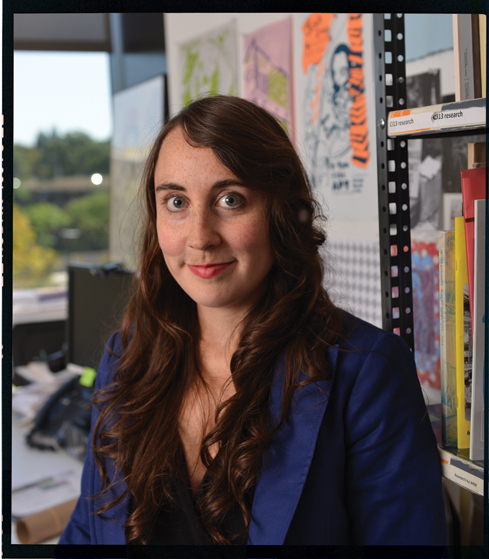 Winter 2012
Winter 2012|
Tina Kukielski
Beneath Tina Kukielski’s calm, quiet demeanor is the heart and nerve of an explorer. The “failed artist” from Massachusetts turned her love of contemporary art and art history into a career as a curator after heeding the advice of co-workers at a small gallery on the campus of the Massachusetts Institute of Technology (MIT). “They had all come from art institutions in New York,” she says, “so they encouraged me to go to New York to find myself.” Kukielski did find herself, quite literally, at the epicenter of one of the biggest events of the 21st century when she took the plunge and moved to the Big Apple—one month before September 11, 2001. Exactly one month after 9/11, Kukielski’s Brooklyn apartment was robbed. “It was a big wake-up call,” she recounts, “but I persevered,” landing a job at the Whitney Museum of American Art the following year. She says that 9/11 “blew open the doors of thinking more globally”—for both her and the New York art world. It would serve as good preparation for her current role as one of three curators of Carnegie Museum of Art’s 2013 Carnegie International. For the past year, she and co-curators Daniel Baumann and Dan Byers have been traversing the globe, surveying art and artists for next year’s global show. How is it co-curating with two other people?Great. We’ve had a lot of time to get to know each other. And I would say that our work life and our private lives easily permeate between one and the other. Decisions are just as likely to be made at 1 a.m. over beer as they are at 9:30 a.m. at the conference table. Why did you decide to establish an artist apartment in Lawrenceville?We wanted to experiment with each other early on, and bounce ideas around. And we wanted it to be this really informal, casual thing, where we could all pitch in ideas. One of the most surprising things to come out of it is how people here want to collaborate. It’s just so shocking to me, because in New York institutions are much more territorial and independent. Once we opened the apartment, so many people and organizations wanted to cohost events. What place surprised you most in your travels?The Middle East. That was by far the trip that made the difference for me. When I went it was the start of the Arab Spring. I went to Beirut first and there were all of these State Department warnings. To see artists operating under those circumstances was really amazing. I suppose what resonated most was the chaos. It felt very invigorating. I was totally scared at one moment but then completely on a high at the next moment. What will be different about the 2013 International?We want to introduce Pittsburgh to our national and international audiences. Pittsburgh is not solely the museum; it’s a collection of neighborhoods that compose the unique character of this place. So we’re building on this idea of slightly unique characters that exist in different locations. Lawrenceville is one of them. The museum’s collection is another, with its own unique character and relationship to the history of the International. We want to talk about that history. It’s very unusual for any biennialstyle exhibition to actually come out of a museum that is a collecting institution. We are proud of that. The Venice Biennial doesn’t collect anything out of its shows. Does that affect how much new art you can bring in?We are getting more creative with how we use space. This museum has plenty of corners and overlooked spaces. And we are starting the show even before you walk through the doors. Will it incorporate other spaces outside of the museum?Beyond what we are doing in Lawrenceville, we had all read about Braddock before we came to Pittsburgh. So we are thinking about how we can collaborate with what already exists there—and how we can bring people to Braddock and bring Braddock to the museum. What would you say to someone intimidated by contemporary art; why come to the International?Bring a friend, don’t go see art by yourself if you might be intimidated by it. And if it can at least elicit a conversation, then you’ve gotten somewhere with it, right?
|
Our Place in Space · Breaking Out of the Cube · Reimagining Home · Southern Exposure · Directors' Note · NewsWorthy · Artistic License: Hacking Reality · Science & Nature: Going Buggy · Field Trip: Where in the World is Carnegie Museums? · The Big Picture
 |
Copyright © 2017 CARNEGIE Magazine. All rights reserved. |

